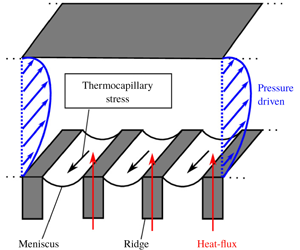Crossref Citations
This article has been cited by the following publications. This list is generated based on data provided by
Crossref.
Crowdy, Darren
2020.
Collective viscous propulsion of a two-dimensional flotilla of Marangoni boats.
Physical Review Fluids,
Vol. 5,
Issue. 12,
Arun, M.G.
Dilip, D.
and
Ranjith, S. Kumar
2021.
Effect of interface curvature on isothermal heat transfer in a hydrophobic microchannel with transverse ribs and cavities.
International Journal of Thermal Sciences,
Vol. 167,
Issue. ,
p.
107014.
Crowdy, Darren
2021.
Viscous propulsion of a two-dimensional Marangoni boat driven by reaction and diffusion of insoluble surfactant.
Physical Review Fluids,
Vol. 6,
Issue. 6,
Yao, Jie
and
Teo, C. J.
2021.
Effect of the liquid–gas interface curvature for a superhydrophobic surface with longitudinal grooves in turbulent flows.
Physics of Fluids,
Vol. 33,
Issue. 7,
Ren, Liuzhen
Hu, Haibao
Bao, Luyao
Zhang, Mengzhuo
Wen, Jun
and
Xie, Luo
2021.
Many-body dissipative particle dynamics study of the local slippage over superhydrophobic surfaces.
Physics of Fluids,
Vol. 33,
Issue. 7,
Baier, Tobias
and
Hardt, Steffen
2022.
Shear flow over a surface containing a groove covered by an incompressible surfactant phase.
Journal of Fluid Mechanics,
Vol. 949,
Issue. ,
Miyoshi, Hiroyuki
Rodriguez-Broadbent, Henry
Curran, Anna
and
Crowdy, Darren
2022.
Longitudinal flow in superhydrophobic channels with partially invaded grooves.
Journal of Engineering Mathematics,
Vol. 137,
Issue. 1,
Hodes, Marc
Kane, Daniel
Bazant, Martin Z.
and
Kirk, Toby L.
2023.
Asymptotic Nusselt numbers for internal flow in the Cassie state.
Journal of Fluid Mechanics,
Vol. 977,
Issue. ,
Crowdy, Darren
Mayer, Michael
and
Hodes, Marc
2023.
Asymmetric thermocapillarity-based pump: Concept and exactly solved model.
Physical Review Fluids,
Vol. 8,
Issue. 9,
Tomlinson, Samuel D.
Gibou, Frédéric
Luzzatto-Fegiz, Paolo
Temprano-Coleto, Fernando
Jensen, Oliver E.
and
Landel, Julien R.
2023.
Laminar drag reduction in surfactant-contaminated superhydrophobic channels.
Journal of Fluid Mechanics,
Vol. 963,
Issue. ,
Tomlinson, Samuel D.
Gibou, Frédéric
Luzzatto-Fegiz, Paolo
Temprano-Coleto, Fernando
Jensen, Oliver E.
and
Landel, Julien R.
2024.
Unsteady evolution of slip and drag in surfactant-contaminated superhydrophobic channels.
Journal of Fluid Mechanics,
Vol. 1000,
Issue. ,
Rahmani, H.
and
Taghavi, S.M.
2024.
A comprehensive model for viscoplastic flows in channels with a patterned wall: longitudinal, transverse and oblique flows.
Journal of Fluid Mechanics,
Vol. 984,
Issue. ,
Tomlinson, Samuel D.
Gibou, Frédéric
Luzzatto-Fegiz, Paolo
Temprano-Coleto, Fernando
Jensen, Oliver E.
and
Landel, Julien R.
2025.
Drag reduction in surfactant-contaminated superhydrophobic channels at high Péclet numbers.
Journal of Fluid Mechanics,
Vol. 1010,
Issue. ,
Lam, Lisa Steigerwalt
2025.
CONDUCTION FOR SHAPE FACTOR FOR A SET OF PARALLEL ISOTHERMAL CYLINDERS IN A SEMI-INFINITE DOMAIN
.
p.
615.
